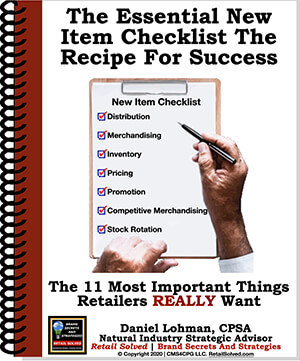True category management is the great equalizer between small brands and their more sophisticated competitors. Mastering these skills will give your brand a significant sustainable competitive advantage.
Aligning your process with retailers' category management strategy will help you stand out in their eyes and establish you as a true partner and potentially, the category captain.
Category management is typically an eight-step process. The best solution for your business is the one that encompasses all of the strategies needed to make your brand successful.
The process you choose will significantly help you achieve the goals you set for your brand. It will be your roadmap to success. This process will establish your brand as a true leader in the category and differentiate you from the competition.
Your goal is to understand your retailer and become an expert with regard to their needs, goals, and objectives for the category, their profit and margin expectations, etc. Aligning your process with their category management strategy will help you stand out in their eyes and establish you as a true partner and potentially, the category captain.
1. Define category
This step is perhaps the most important, as it will define your understanding of the retailer, their customers and the consumers who buy your brand. The key question is: how do customers shop the category? Help you define the category, the consumer decision tree identifies the choices and the order of decisions customers make when they shop the category. Do they choose a brand, sub-brand, quality, flavor/scent, packing, etc.? Do they choose complementary products during the same trip? For example, a customer shopping for your 24-oz. bottle of vanilla scented shampoo might also purchase your 24-oz. bottle of vanilla scented conditioner.
2. Category role
Role identifies the importance of the category to the retailer. This is the role the retailer wants the category to play within their store. A category can be used to bring consumers into the store, increase foot traffic, support routine shopping needs, be a destination for seasonal/occasional purchases, a one-stop-shop or for convenience. Retailers may assign different roles to categories within their stores depending on the customers they want to attract.
3. Category appraisal
Knowing how the category performs at the retailer, within the market, and across different outlets is the next step. This should include a pricing, promotion, placement and product assortment assessment. How does the category performance compare to the competition?
4. Category scorecard
Scorecard is the strategic allocation of work to be performed to reach the category goals and objectives. It is a summary of observations and analysis to help develop goals and targets for the category. It should include an assessment of consumer buying habits.
5. Category strategies
Strategies are used to fine-tune the category role to meet scorecard objectives. Category strategies are designed to grow market share, increase sales, increase foot traffic, improve gross margin, increase return on investment, increase shopping basket size and gain customer satisfaction.
6. Category tactics
Tactics include specific actions to be taken to achieve chosen category strategies. Promoting top brands on a front end cap three times a quarter at a hot price point with a feature is just one example.
7. Implement plan
This is the action step that brings your strategies and tactics to life… where the proverbial rubber meets the road. The degree to which you accurately implement the plan will dictate its success.
8. Review and assess performance
Analyze, measure and review the results. This should be ongoing and used to help you refocus and make changes if necessary.
Click here to see more brand building strategies and to assess the health of your brand
“True Category Management” does not rely on “push-button” analytics. It transcends well beyond traditional resources to develop deep dive actionable consumer-driven insights capable of helping a brand or retailer compete more effectively in any channel and any economy. This is what differentiates me from other solution providers.
What strategies do you use to grow sales?
How do you stand out in a hyper-competitive world?

Want A Competitive Edge? The Recipe For Success
New product innovation is the lifeblood of every brand. New products fuel sustainable growth, attract new shoppers and increase brand awareness. Know the critical steps to get your product on more retailer’s shelves and into the hands of more shoppers.
Empowering Brands | Raising The Bar
Ever wish you just had a roadmap? Well, now you do!
Don’t miss out on all of these FREE RESOURCES (strategic downloadable guides, podcast episodes, list of questions you need to be asking, and know the answers to, the weekly newsletter, articles, and tips of the week. You will also receive access to quick and easy online courses that teach you how to get your brand on the shelf, expand distribution, understand what retailers REALLY want, and address your most pressing challenges and questions.
All tools that you can use, AT NO CHARGE TO YOU, to save you valuable time and money and grow your sales today!
Image is the property of CMS4CPG LLC, distribution or reproduction is expressively prohibited.



